Greenpeace anti-nuclear playing cards
Greenpeace anti-nuclear pack with facts and figures, United Kingdom, 2003.
Unlike the later Greenpeace playing cards which display naive drawings of penguins, seals, whales and dolphins, this earlier pack presents facts about the history and development of nuclear weapons and the threat of their proliferation. Facts and figures are presented on all the cards, including the 2 jokers, with the exception of the aces and kings of each suit. These cards show photographs of the Presidents or Prime Ministers of 8 countries which are known to possess nuclear weapons, with information about the size of their stockpile : China, France, India, Israel, Russia, Pakistan, United Kingdom and the USA. There is an extra card which describes Greenpeace’s first anti-nuclear protest in 1971.
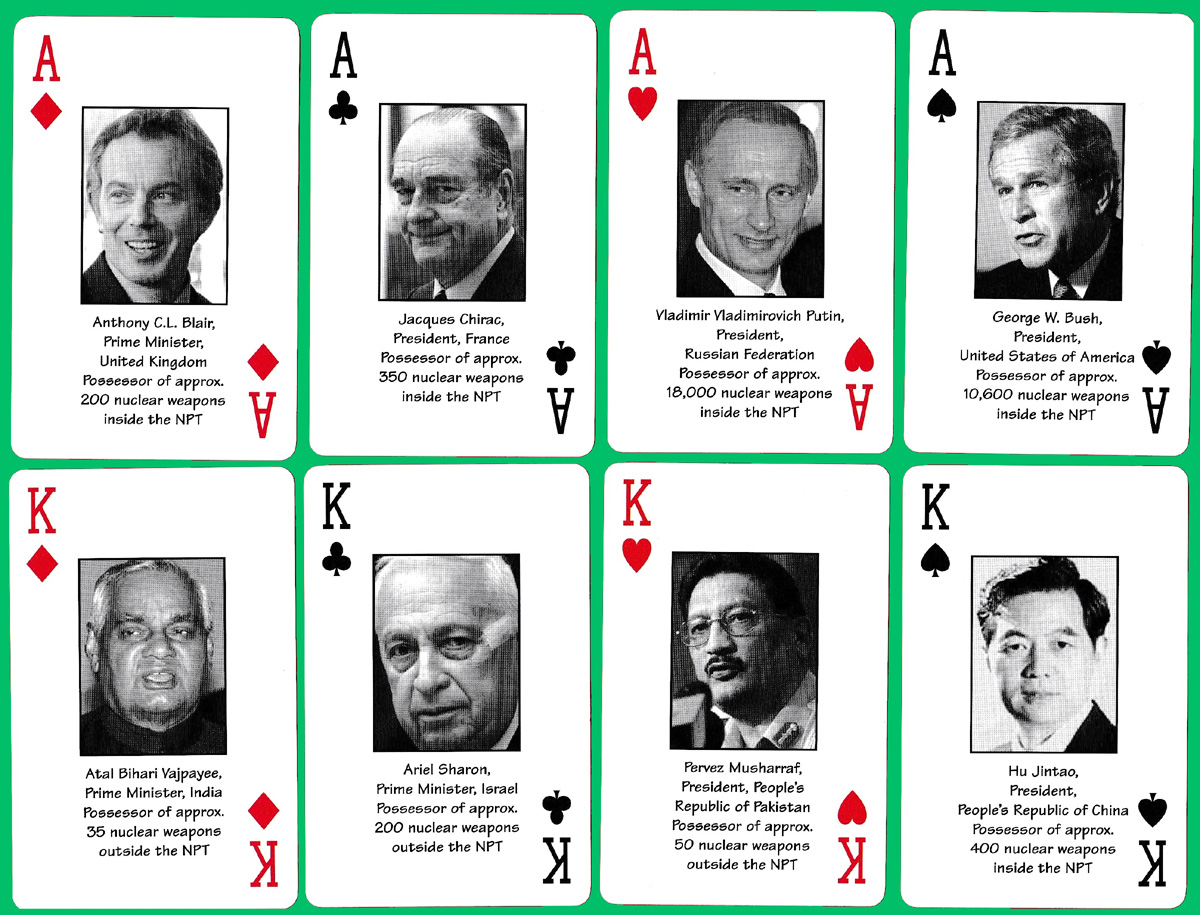

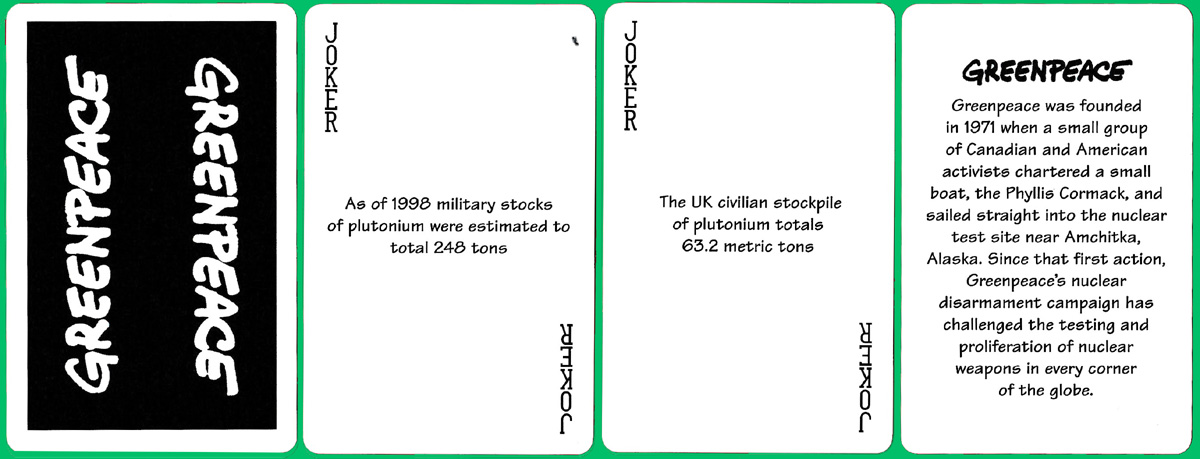
Above: Greenpeace anti-nuclear playing cards, 2003.
By Peter Burnett
United Kingdom • Member since July 27, 2022 • Contact
I graduated in Russian and East European Studies from Birmingham University in 1969. It was as an undergraduate in Moscow in 1968 that I stumbled upon my first 3 packs of “unusual” playing cards which fired my curiosity and thence my life-long interest. I began researching and collecting cards in the early 1970s, since when I’ve acquired over 3,330 packs of non-standard cards, mainly from North America, UK and Western Europe, and of course from Russia and the former communist countries.
Following my retirement from the Bodleian Library in Dec. 2007 I took up a new role as Head of Library Development at the International Network for the Availability of Scientific Publications (INASP) to support library development in low-income countries. This work necessitated regular training visits to many sub-Saharan African countries and also further afield, to Vietnam, Nepal and Bangladesh – all of which provided rich opportunities to further expand my playing card collection.
Since 2019 I’ve been working part-time in the Bodleian Library where I’ve been cataloguing the bequest of the late Donald Welsh, founder of the English Playing Card Society.

Leave a Reply
Your Name
Just nowRelated Articles

Commoners playing cards
Created by Ian Cumpstey dedicated to the common land and the countryside.

Gone to Pot: Gardener’s playing cards
‘Gone to Pot’: special playing cards for keen gardeners, United Kingdom.
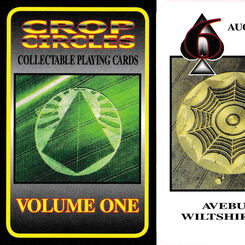
Crop Circles collectable playing cards
Crop Circles collectable playing cards with photography by Lucy Pringle, United Kingdom, 2007.
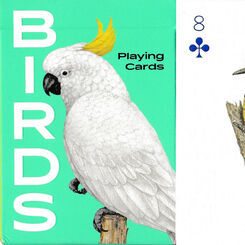
Birds playing cards
Birds playing cards illustrated by Ryuto Miyake, 2019.
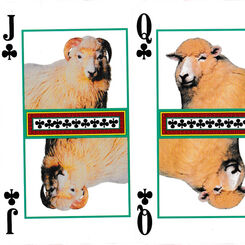
Axminster 100 playing cards
Special non-standard pack produced for Axminster Carpets Ltd.

A Bouquet of Pheasants
A Bouquet of Pheasants playing cards produced by Jennifer Gaudion, United Kingdom, 2019.

Island 2000 Trust
“Island 2000 Trust” sustainability project playing cards, Isle of Wight, United Kingdom, c. 2005.
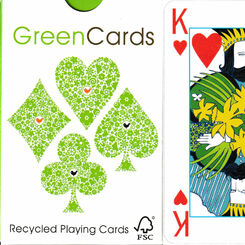
Green Cards
Recycled playing cards with striking, non-standard courts.
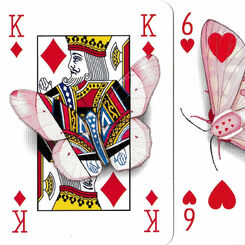
Cryptic Cards
Cryptic cards created by Immy Smith, United Kingdom, 2017

Animal Aid playing cards
Animal Aid playing cards with anti-shooting cartoons created by Steve Hutton.

The Mrs. Forster Collection
Playing cards featuring original botanical paintings by Mrs. Sidney Eliza Forster from the 1890s.
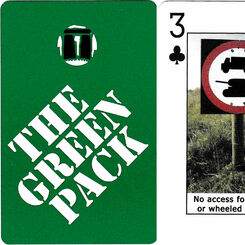
The Green Pack: Salisbury Plain
The Green Pack: Salisbury Plain, United Kingdom, 2004.

Hillbaggers Top 52 playing cards
Hillbaggers Top 52 playing cards designed by Caroline McCann, 2019.
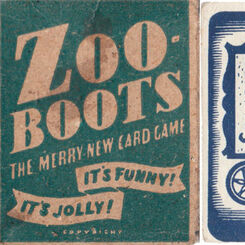
Zoo-Boots
Zoo-Boots published by E. S. & A. Robinson, c.1930s.

Consil
Consil by Multum in Parvo Company,c.1900.

Greenpeace Playing Cards
Campaign deck for Greenpeace with drawings of penguins, seals, whales and dolphins.

Freddy the Fox
Freddy the Fox card game published by Valentine & Sons, Ltd, c.1910.

Under the Sea
“Under the Sea” transformation playing cards, published in 2005 to raise money for the Marine Stewar...

The Muddled Menagerie
The Muddled Menagerie card game published by Valentine & Sons Ltd, Dundee & London, c.1900.

Language of Flowers
Language of Flowers by Past Times, c.1999.
Most Popular
Our top articles from the past 60 days


 Your comment here. Your comment here. Your comment here. Your comment here. Your comment here. Your comment here. Your comment here. Your comment here. Your comment here. Your comment here. Your comment here. Your comment here. Your comment here. Your comment here. Your comment here. Your comment here. Your comment here. Your comment here. Your comment here. Your comment here. Your comment here. Your comment here. Your comment here. Your comment here. Your comment here. Your comment here. Your comment here. Your comment here. Your comment here. Your comment here. Your comment here. Your comment here.
Your comment here. Your comment here. Your comment here. Your comment here. Your comment here. Your comment here. Your comment here. Your comment here. Your comment here. Your comment here. Your comment here. Your comment here. Your comment here. Your comment here. Your comment here. Your comment here. Your comment here. Your comment here. Your comment here. Your comment here. Your comment here. Your comment here. Your comment here. Your comment here. Your comment here. Your comment here. Your comment here. Your comment here. Your comment here. Your comment here. Your comment here. Your comment here.




















